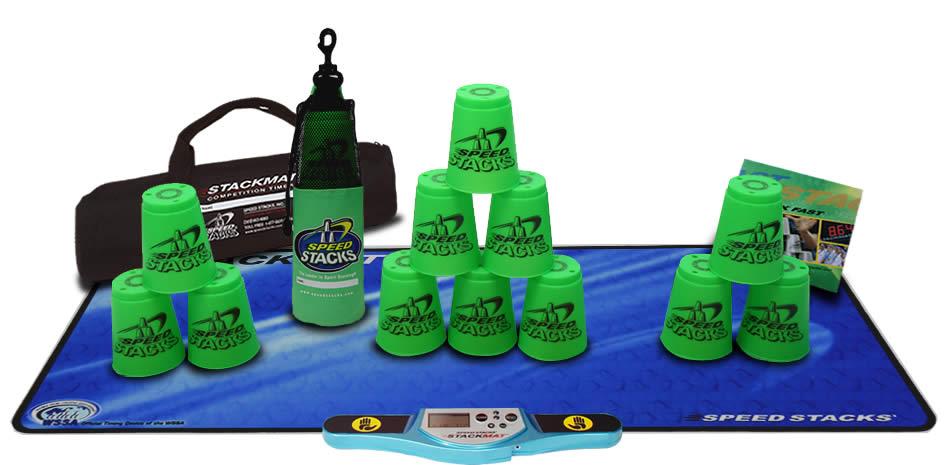


March 2011
In this Issue: Reader feedback: A story inspired by Rory's Story Cubes!
|
Say
It Quick |
Discoveries bits of serendipity to inspire and motivate |
Ideas fuel for your own continuous learning |
Activities tips and tricks you can try today |
| Doing the Dishes | Speed Stacking | The Cup Half Full | Quick Stack |
This month, explore the interaction of speed, efficiency, and flow beginning with this story of only 99 words.
Doing the
Dishes
I like washing the dishes. It's a way to help out when I haven't done the
cooking. There's one thing I've never been able to get a handle on, though.
Just as I dry my hands, I'll turn around and find another dirty plate, cup,
or pot slouching nonchalantly in a corner. How did I miss that?
Frustrating!
I used to look for someone to blame for this phenomenon: my spouse, our child, a gremlin. Then I realized everything has its use. And that's what dishes are for: to wash, to use, to get dirty again!
 Speed
Stacking
Speed
Stacking
Usually I associate stacking cups with cleaning up after dinner. But my thinking
has changed since learning about Speed
Stacking, the sport of building pyramid towers of plastic cups, then collapsing
them, in record time. Competitive Sport Stacking, as it is also known, has
been integrated into thousands of schools across the U.S., Canada and Europe.
It has become both an extracurricular activity and a boredom-buster in the
classroom for students who need a mental break from academics.
Using specially designed cups that are uniformly weighted and won't stick together, players race the clock to stack and unstack towers of three, six, or ten cups. There are singles, doubles, and relay events at the World Sport Stacking Competition which will be held this year in Dallas, Texas.
Speed Stacking is easy to learn. With ordinary paper cups at your kitchen table, you can learn the basic moves in a few minutes but you can spend hours perfecting your technique and improving your time. Watching practiced competitors, the cups seem to levitate into place then flow like liquid mercury back to where they started. Click here to see ten-year-old Steven Purugganan, the world champion, in action.
Though it sounds like a fun activity for young people, I first learned about Speed Stacking at a conference of the North American Simulation and Gaming Association. There it was introduced as a hands-on technique to demonstrate learning styles, coaching methods, group problem solving techniques, and creative thinking methods.
With that in mind, don't be surprised to find a stack of brightly colored cups and a timer at your next team retreat or training event!
The Cup Half
Full
The "speed" part of Speed Stacking comes with practice but there also are
some techniques that, if followed consistently, will help players achieve
faster times right away. One simple trick is to handle each cup only once.
Another is to never pass a cup from one hand to the other. So, if you are
ambidextrous, you already have an edge.
Doing equal work with both hands is one of the skills that Speed Stacking builds. Ambidexterity is helpful in computer work, playing musical instruments, playing many sports, and operating machinery. (Not to mention winning a pie-eating contest!) But how necessary is such a skill for most everyday tasks?
Turns out it may be more important than at first glance. Since each hand is controlled by its opposite hemisphere you have to develop both sides of your brain to use your hands with equal dexterity. So stacking cups quickly with fluid precision and coordination beefs up brain cells on both sides of the corpus callosum. Stacking plastic cups, and learning to do it well, builds a well-rounded brain.
Would regular practice in an ambidextrous activity increase brain capacity and flexibility for other activities? What effect might it have on problem solving, creativity, or possibility thinking? Though I don't have scientific research to back it up, it seems logical that the neuronal connections necessary to produce fluid hand coordination would also contribute to a natural flow of mental coordination for other activities.
From a metaphorical point of view, Speed Stacking is about moving to a rhythm that generates a natural flow. It is brain and body coordinated for a common purpose where all elements contribute in harmony to a greater goal.
Whether we're talking about brain-hand coordination, teamwork, or positive relationships at home, when we resist that natural flow, the cups fall down, accumulate in the sink, and cause consternation.
Quick Stack
By David Gouthro
David Gouthro is the principle force behind The Consulting Edge: Movers & Shakers, Inc., where he provides innovative facilitation and training that's fun and effective. Here he describes several ways to use Speed Stacking as a teaching tool. Try some of them with your group then let your fellow readers know what happened.
Here are four different ways to use the concepts imbedded in the sport of Speed Stacking. Each has begins with the principle or central concept to be learned, and follows with just enough detail to be dangerous!
The importance of using the correct tools.
After demonstrating how to stack one of the competition stacks (for example, the 3-3-3 stack which is described on the Speed Stacking website), provide groups with different cups to attempt the same competitive stack. For example, provide one group with regular plastic cups, another with Dixie cups, a third with relish cups, and a fourth with unbreakable polycarbonate cups.Tell the groups that there's going to be a timed competition, and that they have 5 minutes to practice. It soon becomes obvious, that in order to accomplish the task, the use of the correct tool is a tremendous advantage. You will note that the speed stacking cups are custom designed for this challenge, as described above.
From here, enter into a conversation to explore the extent to which employees have the tools at work to perform at their best.
Different ways to teach; Different ways to learn
Separate the group into three. One group is provided with written instructions regarding how to do the 3-3-3 stack correctly. A second group is shown by the instructor how to do a 3-3-3 stack, and they are able to ask questions. The third group is allowed to see a video clip, describing how to do the same stack. Bring the groups back together after they have had an opportunity to practice, and request that they demonstrate the skill that they have acquired. In a debriefing, ask people to relate how effective each method of instruction appeared to be.A twist on this is to show the impact of demonstration methods. One group can be shown how to do the 3-3-3 stack by the instructor. Another can be shown by a professional via video. And a third simply gets to watch world champions perform the stack in a competition. In the debriefing, focus the conversation around the level of motivation (or sense of hope and possibility) that is generated when one observes a relative novice demonstrating the skill, versus a practiced expert. Does the "expert" inspire someone to try harder; or demotivate, because the new learner can't even imagine being able to perform at that level? This is a great conversation for train-the-trainer sessions!
The impact of competition
Each table is asked to have each individual at the table practice the skills of creating the 3-3-3 stack and to record their times as they get better. After 10 minutes, they are asked to determine which of their table members would best represent their table in a competition.That person is paired up with a member from another team. They are then asked to compete against each other, stacking as quickly as possible. The tension can be increased with the use of a device called the battle stack, where competitors literally face off against each other. Whoever completes their stack first, presses a release mechanism that causes the other individual's cups to go flying.
The conversation that ensues can compare the fastest time the individual had at their own table where there was no competition to the time they achieved in the heat of competition. Debriefing can follow on the performance impact of the competitive environment, or virtually any other aspect of the benefits or detriments of competition.
Enhancing individual performance in a team environment
Set an objective that each member of the team should achieve a certain level of performance. The challenge is for the team members who are fastest to coach and support those who are not quite as fast.Overall team performance could be evaluated by the number of participants who achieve a predetermined minimum time, or an accumulated team time for each person to do the 3-3-3 stack.
From here, explore through conversation the impact of individual targets versus team targets, the processes by which individual team performance was improved for the benefit of the individual and the team, etc.
David Gouthro The Consulting Edge: Movers & Shakers, Inc. 102-2221 Folkestone Way West Vancouver, BC V7S 2Y6 (604) 926-6858 or (800) 685-6818 http://www.theconsultingedge.com
Read previous
issues. Click Archives!
To add or delete your name to our mailing list, email
with a short note in the subject line.
I want this newsletter to be practical, succinct, and thoughtful. If you have suggestions about how we can meet these criteria, please let us know! Send us an with your thoughts and ideas.
Home
| Services
| Products
| Mission
| Ideas |
The Group
| The Buzz
(c)
2005 - 2010 The Firefly Group